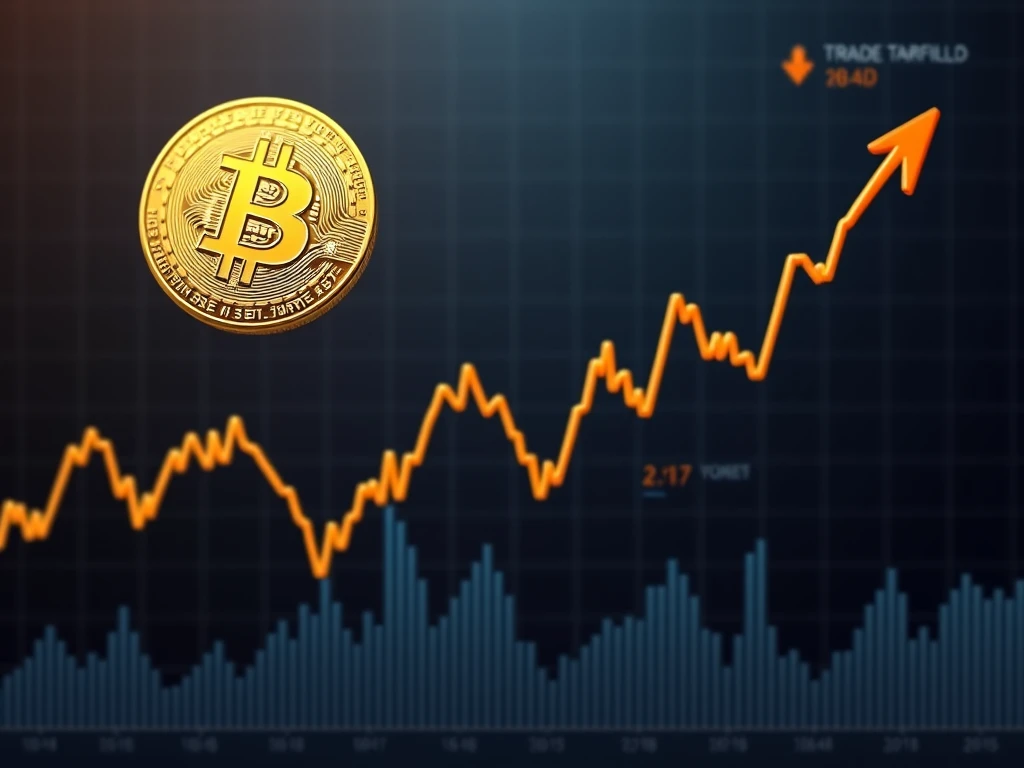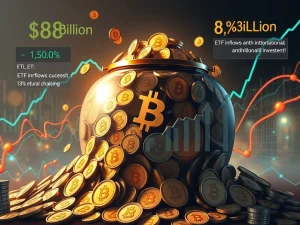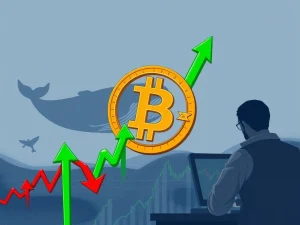Bitcoin Price Aims for $90K: Bold Target as Tariff Relief Sparks Treasury Yield Drop

Bitcoin enthusiasts are buzzing with anticipation, setting their sights on a potential $90,000 price target. This bullish outlook comes as US Treasury yields experience a dip, seemingly fueled by recent adjustments to the Trump administration’s tariff policies. Could this be the perfect storm for another significant Bitcoin rally? Let’s dive into the market dynamics and expert insights.
Decoding the Drop in Treasury Yields and its Bitcoin Price Impact
The recent week witnessed a noteworthy shift in the traditional finance landscape, directly influencing the crypto sphere. Both the 2-year and 10-year US Treasury yields saw a decline on Monday, April 14th. This occurred right after Bitcoin (BTC) wrapped up its most impressive weekly performance since early January. Bitcoin’s price jumped by a substantial 6.79% last week, prompting the crucial question: Are the stars aligning for a sustained upward trajectory?
Specifically, the 10-year treasury yield decreased by 8.2 basis points to settle at 4.40% during New York trading hours. Simultaneously, the 2-year treasury yield also slipped by 8 basis points, reaching 3.88%. This yield reduction is largely attributed to potential tariff exemptions on key tech products like smartphones, computers, and semiconductors. These exemptions are designed to provide breathing room for US companies to relocate production domestically. However, it’s crucial to note President Trump’s emphasis on the temporary nature of these tariff reliefs.
| Treasury Yield | Change | New Rate |
|---|---|---|
| 10-Year US Treasury Yield | Down 8.2 basis points | 4.40% |
| 2-Year US Treasury Yield | Down 8 basis points | 3.88% |
The interplay between easing US treasury yields and Bitcoin is complex. On one hand, lower yields can diminish the allure of fixed-income investments, potentially diverting capital towards riskier assets like Bitcoin. This influx of capital could act as a catalyst for upward price movement. However, the temporary nature of tariff exemptions and the broader context of the US-China trade dynamics introduce an element of uncertainty, making Bitcoin susceptible to price swings.
Tariff Exemptions and Inflation Fears: Fueling Bitcoin’s Store of Value Narrative?
Bitcoin’s role as an “inflation hedge” remains a subject of ongoing debate. Yet, the current climate of uncertainty surrounding trade policies appears to be amplifying inflation concerns. This, in turn, strengthens Bitcoin’s narrative as a store of value. When traditional markets face turbulence or inflationary pressures, investors often seek refuge in assets perceived as safe havens or inflation-resistant. Bitcoin, with its decentralized nature and limited supply, is increasingly viewed as such an asset by some market participants.
Countering this narrative, recent US inflation data paints a slightly different picture. The Consumer Price Index (CPI) for March 2025 indicated a year-over-year inflation rate of 2.4%, a decrease from 2.8% in February. This marks the lowest inflation rate since February 2023. From a purely data-driven perspective, cooling inflation could be interpreted as indirectly bearish for Bitcoin in the short term, as it lessens the immediate urgency for inflation-hedging assets.
Bitcoin Price Hurdles: $88K to $90K Range in Focus
Market analysis from Trading resource Material Indicators highlights Bitcoin’s current technical standing. Bitcoin has successfully maintained a bullish position above its 50-weekly moving average and the quarterly open price of $82,500. This robust weekly close suggests a reduced likelihood of Bitcoin revisiting recent weekly lows in the near future.
However, the path to higher prices isn’t without obstacles. Material Indicators points out significant technical and liquidity-based resistance between the current price level and the 200-day moving average. Specifically, they anticipate strong “ask” orders—sell orders—around the $88,000 and $92,000 price points. These levels could act as temporary ceilings, potentially slowing down or pausing Bitcoin’s upward momentum as buyers need to absorb this selling pressure.
Perpetual-Spot Gap: Is a Bullish Reversal Imminent?
Adding another layer to the market analysis, Alphractal founder Joao Wedson suggests a potential bullish reversal for Bitcoin is on the horizon. His analysis centers on the Perpetual-Spot Gap on Binance. This indicator tracks the price difference between Bitcoin’s perpetual futures contracts and its spot market price. A narrowing gap, especially when it turns negative, can signal a weakening bearish sentiment.
Wedson’s observations, shared in a recent X post, reveal that this gap has been contracting since late 2024 and is currently negative. Historically, periods from 2020-2021 and 2024 have shown that a shift to a positive gap often precedes a Bitcoin rally. A positive gap would indicate returning buyer enthusiasm and momentum. However, Wedson also wisely cautions that negative gaps can persist during bear markets, as evidenced by the 2022-2023 period. Therefore, while the narrowing gap is a potentially encouraging sign, it’s not a definitive guarantee of an immediate price surge.
| Gap Status | Potential Market Signal |
|---|---|
| Narrowing Negative Gap | Fading bearish sentiment, potential bullish reversal |
| Positive Gap | Returning buyer momentum, potential rally |
| Negative Gap (during bear market) | Sustained bearish sentiment |
Disclaimer: This analysis is for informational purposes only and should not be considered financial advice. Trading cryptocurrencies involves substantial risk. Always conduct thorough research and consult with a financial advisor before making any investment decisions.









